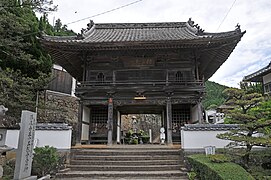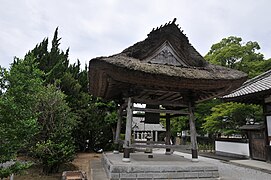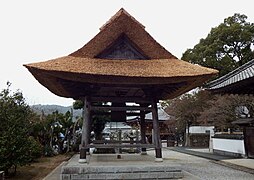Butsumoku-ji
The Butsumoku-ji ( Japanese 佛 木 寺 ), with the Go Ikkasan ( 一 ? 山 ) and Birushanain ( 毘盧 舎 那 院 ) is a temple of the Omuro branch ( 御 室 派 ) of Shingon Buddhism in the city of Uwajima ( Ehime Prefecture ). In the traditional count it is the 42nd temple on the Shikoku pilgrimage route .
history
In the year 807 Priest Kūkai met an old man in this area who was pulling a buffalo behind him. He accepted the old man's offer, sat on the buffalo, and found a pearl in the shade of a large camphor tree that blinded his eyes. It was exactly the pearl that he had thrown into the sea together with a singing bowl ( 三 鈷Sansha ) after a happy return from the Tang period China, turning to the east . Kūkai felt that this area was suitable for a place of prayer and built a temple. He made a figure of the Dainichi Buddha out of camphor wood and hid the pearl in the center of his forehead. He called the temple "Issan-Butsumoku-ji" ( 一山 仏 木 寺 ) and donated copies of the Han'nya ( 般若 経 ) and the Kegon Sutra ( 華 厳 経 ) made in grass script .
The temple enjoyed a reputation that the holy Dainichi, worshiped here, was good for the health of cattle and horses. In the Kamakura period it became the Saionji prayer and burial temple . During the civil war in the 16th century, the temple was destroyed, but was gradually rebuilt afterwards.
investment
You enter the temple through the Niō gate ( 仁王 門 ; 1), which is designed here as a tower gate. One then climbs up a flight of stairs to the temple grounds, on which the main hall ( 本 堂 , Hondō; 2) and the hall dedicated to the temple founder, the Daishidō ( 大師 堂 ; 3), stand in the background . The current main hall had the third head of the Yoshida-Han, Date Muranobu ( 伊達 村 信 ; 1720–1765)) built.
On the way there you pass the pavilion dedicated to Prince Shōtoku ( 聖 徳 太子 堂 ; 4) and the pavilion for Saint Fudō ( 不 動 堂 ; 5) on the right. The temple bell ( 鐘楼 Shōrō ; 6) from the Genroku period (1688–1704 ) stands in front of the monastery building. It is the only one in Japan whose case is not covered with wood or copper, but with sticks. Finally, reference should be made to the side entrance ( 通用 門 Tsūyōmon ; 8), which leads to the monastery buildings and on to the temple grounds.
Treasures
Consisting of a piece of wood of the plum yew seated figure of the revered in the temple holy Dainichi Nyorai (prepared 木造大日如来座像 Mokuzō Dainichi Nyorai zazo ) is 120.2 cm high. On the back it shows the date 健 治 元 (1275) painted in black letters , so it comes from the middle Kamakura period. This Dainichi, who is holding two pearls, is registered as a cultural asset of the prefecture.
In the Dashidō there is a seated figure of Kūkai made of wood ( 木造 弘法 大師 坐像 Mokuzō Kōbō Daishi zazō ). It is made of Hinoki pieces, 87.5 cm tall, and holds a ball ( 念 玉 Nendama ) in her left hand and a gokosho ( 五 鈷 杵 ) in her right hand . It dates from 1315 and is also registered as a cultural asset of the prefecture.
photos
literature
- Butsumoku-ji . In: Ehime-ken kotogakko chireki komin bukai rekishi bukai (ed.): Ehime-ken no rekishi sampo . Yamakawa Shuppan, 2008, ISBN 978-4-634-24638-6 , pp. 222-223 .
- Oguri, Doei: Kukai. Shikoku hachijuhachi kosho no arukikata. Chukei no Bunko, 2011, ISBN 978-4-8061-4067-2 .
Web links
Coordinates: 33 ° 18 ′ 38.1 ″ N , 132 ° 34 ′ 53.3 ″ E
← Previous Temple: Ryūkō-ji | Butsumoku-ji | Next temple: Meiseki-ji →





